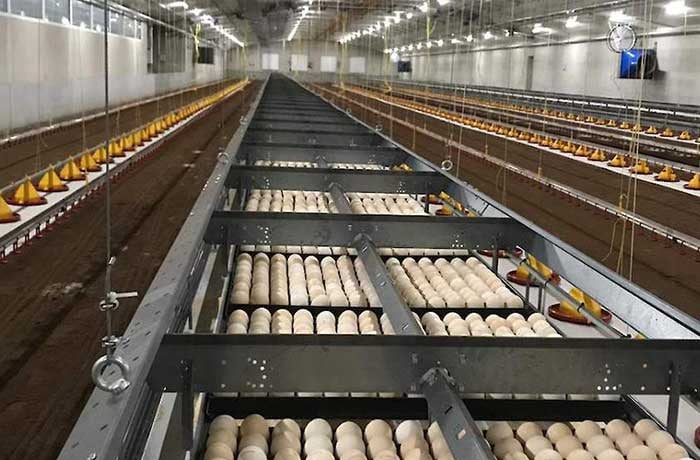Marco Steinz (42) and his wife Doreen keep more than 200,000 broilers in Saxony, Germany. Doing business in the east of Germany is the same as in the Netherlands, but also a little different; you have to take that difference into account, otherwise it won't work. In 2017, Marco switched to 'on-farm hatching' with the X-Treck system. That switch was made all at once and was therefore quite exciting.
Marco Steinz has worked in Germany for nineteen years, which you can tell from his light German accent. Marco: "I started in Germany as a manager on two dairy farms, but I've always had the idea of keeping chickens. Moreover, poultry prices are more stable than dairy cattle prices. And German poultry prices are again more stable than those in the Netherlands, because the Dutch market reacts much faster to imports."
Not the best
According to Marco, doing business in the east of Germany is the same as in the Netherlands. Although there are small differences that can become very large if you do not take them into account. "Doing business here is the same as in the Netherlands. But as a Dutchman you often have a tendency to play the game a little harder, but you have to be careful with that. If someone really mentions their bottom price, you should stop there and not try to make the most of it again. And what really isn't possible, in order to get the price negotiations moving, is to put down a rude low price. Then they don't look at you any more. Marco therefore points out the importance of preliminary research before you start price negotiations in the east of Germany: what is a normal price and what exactly is the room for negotiation?
Tierwohl initiative
While in the Netherlands there are many different concepts for poultry farmers such as Beter Leven Kip (Better Life Chicken) or the Goed Nest Kip (Good Litter Chicken), according to Marco in Germany Initiative Tierwohl (ITW) is particularly important. Apart from more Beschäftigungsmaterial, ITW mainly focuses on fewer animals in the house: 35 kg per m2 compared to a normal 39 kg (and in the Netherlands 42 kg). Marco: "We have a total of 208,000 licensed barns divided over our five barns: one 1,750 m2 barn and four 1,800 m2 barns. Participating in ITW therefore means that we have 21,000 animals less in the stables. ITW broilers are paid a little better.
The big profit
Initiative Tierwohl strives for a higher level of animal welfare and that is why, according to Marco, it fits in so well with on-farm hatching. "You're no longer on the road with newly-hatched chicks and that's where the big gain for Tierwohl lies. A stress-free start for the chicks is more pleasant for the animals and for me it means that the chicks are ultimately stronger and barely suffer from enterococci. I hope that within the poultry sector things will really move in the direction of on-farm hatching. As an industry, we can only survive if we take account of animal welfare and ensure that the animals are healthy. But then, of course, the prices we get for our products must also be right.
At work level
In 2017, Marco began to take a serious look at on farm hatching systems and quickly arrived at the Vencomatic Group system. "For a company with more than 200,000 animals, the X-Treck is the easiest because this system hangs at working height. So no racks on the floor and no searching on the barn floor for eggs that have not hatched". Marco consulted a lot with poultry farmers in the Netherlands who already worked with X-Treck. "On Twitter I saw photos and information about X-Treck and so I came into contact with farmers who were already using the system. I asked them about their experiences. How does it work? And how much work is it to switch to X-Treck? I was told that the changeover was not too bad".
Fair approach
Afterwards, someone from Vencomatic Group visited Marco. "What is striking is the honest approach of the people at Vencomatic. From hatchery chicks to on farm hatching is a big step; you are going to take over part of the hatchery's work such as selecting the chicks. They told me honestly what was in store for me and I could also come to the Netherlands to look at farms that already had X-Treck". Then someone from Vencomatic came to have a look in the stables. They looked at where the beams in the ceiling of the stables run and everything was accurately measured and incorporated in the drawings. "They really do everything they can to make the switch work.
Celebrating Christmas at home
In December 2017, everything was ready for the switch to on-farm hatching. Marco: "That was quite exciting, because we had decided to do all five stables at once. Thanks to the very thorough preparation of Vencomatic, we succeeded and we helped ourselves as much as we could. All X-Treck parts were delivered in one go; no back order was needed. All five sheds were ready within three weeks. And when they had tidied everything up neatly, we could all go home and celebrate Christmas". After everything had been disinfected, the first eggs arrived in January 2018.
Beautifully beautiful
The first time the eggs hatched in Marco's stables, an employee of Vencomatic Group was present. "Before the eggs hatched, he took a good look at the ventilation. He measured everything to make sure there was not too much wind over the eggs; where necessary, this was adjusted". Because there was a lot of interest from his German colleagues, Marco organised an open day for them. "Surely they wanted to see exactly how that works with on-farm hatching and X-Treck. Our open day was well-attended by poultry farmers from all over Germany. On average, 98% of the eggs now hatch. A good result which, according to Marco, is also thanks to the Schotman hatchery in the Netherlands. "A good result is beautiful, but what is especially beautiful is hatching in the house; a miracle that silences you."












.png?width=160&height=132&name=Egg%20packers%20-%20Vencomatic%20Group%20(2).png)
.png?width=160&height=132&name=Meggsius%20Select%20-%20Vencomatic%20Group%20(2).png)














